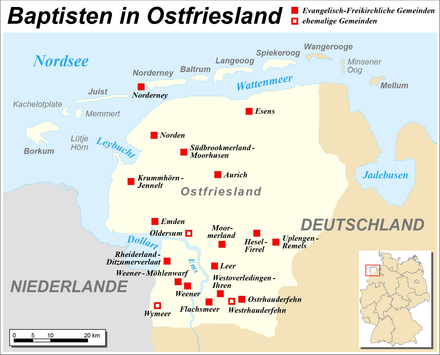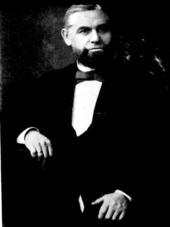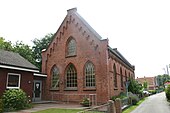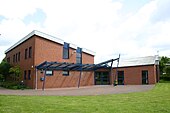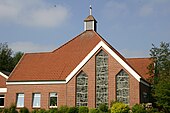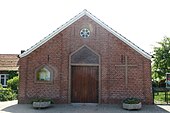Baptists in East Frisia
The beginnings of the Baptists in East Frisia go back to the 1820s, but their real history does not begin until 1845. Today, 14 independent Baptist congregations with four subsidiary congregations are located in East Frisia . Organizationally, they belong to the Evangelical Free Church State Association of Baptists in the Northwest and, within this state association, to the regional association Ems-Jade-Mission (EJM).
history
In 1827 Johann Gerhard Oncken , who later became the founder of German Baptism , traveled to the Netherlands from his residence in Hamburg . His route took him through Leer . Here he boarded the Ems ferry near Leerort and distributed Christian tracts among the passengers . One of these pamphlets also fell into the hands of Christian Bonk , a merchant from Leer , who spontaneously expressed the desire to make Oncken's acquaintance. Oncken, who was the secretary of the Lower Saxony Tract Society at the time, accepted the invitation and spent several days in the house of the Leer merchant family on his return trip.
The Friends of the Bonk family also included Gottfried Wilhelm Lehmann , who, along with Johann Gerhard Oncken and Julius Köbner, is one of the founding fathers of the German Baptists. Lehmann came from Berlin , had with his uncle in Leer Sattler craft learned and under the influence of an " awakened " circle of young people converted . Then he returned to his home in Berlin. A connection developed between Oncken and Lehmann from 1830 - probably through Bonk's mediation - which initially consisted of an exchange of letters and soon afterwards led to a personal encounter. In 1834 Oncken was baptized by the American theology professor Barnas Sears in the Elbe near Hamburg and then founded the first German Baptist congregation with six other baptized people. On May 13, 1837, Oncken baptized Gottfried Wilhelm Lehmann in Berlin and appointed him elder of the Berlin Baptist congregation, which was constituted two days after the baptism.
Over the years there was close contact between Lehmann and Christian Bonk, which was maintained not least through various stays in Leer. In 1840 Lehmann traveled to London to get in touch with English Baptists. On both the outward and return journeys from, he again visited the friends in Leer and held very well-attended evangelistic meetings on this occasion , which triggered a “great movement” among the participants. Lehmann must also have spoken about the baptism of believers at these events . The reason for this was probably members of the Mennonite Church in Leer , who were present at the evangelism mentioned above. The meetings did not go without fruit. A small group of interested people emerged who was subsequently accompanied by the Jeveran Baptists Johann Ludwig Hinrichs and Anton Friedrich Remmers . On New Year's Day 1842, Lehmann was again a guest in Leer and gave a lecture in the Bonk family's home on questions about baptism and the congregation . But it was still three years before Bonk decided to be baptized. In the fall of 1845 Johann Gerhard Oncken came to Leer and on October 18 baptized Christian Bonk and with him Hinrich Coords, who also belonged to the circle mentioned. Both are considered to be the first East Frisian Baptists.
In the following years the Baptist Congregation was established, which opened numerous preaching stations in the Dutch and East Frisian area, which only a little later grew into independent congregations. The Jeveran village school teacher Johann Ludwig Hinrichs , the Middle Franconian journeyman Johann Carl Cramer , the Rheiderland blacksmith Johann Pieter de Neui and the theologian in peasant skirt Harm Willms played a decisive role in this development .
The young Baptist movement suffered a painful bloodletting from the emigration of many parishioners to the United States . The reasons for emigrating are complex, but a key factor is the freedom of belief , which Baptists and other dissidents in East Frisia were denied until the 1870s. The wave of emigration reached its peak in the years 1865 to 1869.
Communities
In 2011 there were fourteen Baptist congregations in East Friesland with a total of four non-independent branches. One of the East Frisian branches, the Baptist Congregation Ostrhauderfehn, is a branch of the Ammerland Baptist Congregation Augustfehn . With the Baptist congregations in Wilhelmshaven, Barßel and in the district of Friesland , the East Frisian Baptists are united in the regional association Ems-Jade-Mission . In addition, they belong to the Evangelical Free Church State Association of Baptists in the Northwest and the Federation of Evangelical Free Church Congregations in Germany .
Aurich district
The oldest Baptist congregation in the Aurich district is in Jennelt . It was founded in Hamswehrum in 1865 as the daughter of the Ihrer Baptist congregation and ten years later relocated to the Krummhorn village of Jennelt. In the years and decades that followed, the Jennelter congregation became the mother congregation of the Northern, Emder, Moorhusener and Aurich Baptists.
The second oldest Baptist congregation in the Aurich district is the congregation of the Christ Church in the north . Its beginnings go back to Johann Carl Cramer (1825–1850). The Northern Baptists were constituted as an independent congregation in 1900. Their chapel was built in the same year. Since 1957 the building has officially been called the "Christ Church". On Norderney there has been a branch of the Christ Church in the north since the 1990s, which gathers in the premises of the Nordneyer Seehospice .
Although the beginnings of the Moorhusen Baptist congregation go back to the 1840s, it did not become independent until 1908. In 1936 the premises became too small, so that a preacher's house was added to the chapel and the vacant rooms of the old apartment were used as congregation rooms could become. In 1964 the chapel was rebuilt on a larger scale. The church service room, which is still in use today, was attached to the building. In 1973/74, the preacher's house was built in front of it. The last construction work so far took place in the years 2008 to 2010.
The municipality of the district town of Aurich is the youngest in the district. Originally it was a branch of the Jennelter and then the Moorhusener Baptist Church. Eventually she was assigned to the Emden community and remained their daughter until she became independent in 1961. Until 1958, the community meetings took place in the Ulricianum grammar school . The Kreuzkirche , a so-called brewer's chapel , inaugurated in 1958 , on Eickebuscher Weg served as a community center for around 40 years. The Evangelical Free Church of Aurich has had its domicile in the newly built community center on Oldersumer Strasse in Aurich-Rahe since 1998.
Wittmund district
The only Baptist church in the Wittmund district is located in Esens . It was created in the 1990s and goes back to a church planting initiative of the Ems-Jade Mission . She became self-employed in 2007. Before that, she was a branch of the Evangelical Free Church Community (Baptist) Norden . Their services took place first in private houses and then in the Esenser Peldemühle . In 1994 she received her own community center on Hohekamp, which was built from ten containers . In 2011, the foundation stone for a new community center was laid next to the container church. The inauguration of the new church took place in October 2012.
The Baptists living in the other places in the Wittmund district belong to the surrounding Evangelical Free Church communities. Wittmund parishioners usually orientate themselves towards Jever , Horstener towards Wilhelmshaven and Baptists from the greater Friedeburg area towards Firrel .
City of Emden
The Emden Baptist Congregation has a special history . It is not a genuinely Baptist church plant, but has one of its most important roots in the Huguenot congregation of the “departed under the cross” (also known as the French Reformed congregation ), some of which turned to the Baptist understanding of baptism and congregation - including their preacher Samuel Cornelius de Haan. A first baptism of 13 former members of the "Congregation under the Cross" took place on June 7, 1866. They formed a preaching station for the Baptist Congregation Hamswehrum (later: Jennelt) and from 1868 were cared for by preacher Mekke Willms Swyter . The church of the French Reformed congregation also came into the possession of the Emden Baptists. The official constitution as an independent Baptist congregation took place in 1902. At the moment (2012) it is the largest among the East Frisian Baptist congregations.
District of Leer
There are a total of eight independent Baptist congregations and two branches in the district of Leer. This means that more than half of the East Frisian Baptist congregations are located here. Baptists make up 0.83% of the total population of the county. In no other region of Germany are the Baptists more represented. The Baptist congregations of Firrel and Remels represent a specialty in the district of Leer. While all other congregations of this Free Church participate in the corporate rights of the Federation of Evangelical Free Churches, the congregations mentioned, which were part of the Baptist congregation of Firrel-Remels until 2004, have their own corporate rights, they were awarded in 1985 by the Lower Saxony Ministry of Culture. After their organizational separation, both now independent local congregations received their own corporate rights.
The beginnings of the Baptist church in yours have already been described in detail in the history section. Her church is now on Kapellenweg in Westoverledingen . The previous building, the house for worship , is located on the same property and was integrated into the new building. Today it serves as a space for community events. In Flachsmeer , the community maintained a small church as a branch, which was used for weekly events, among other things.
The Weener Baptist Congregation owns a church building in Weener and another community center in Möhlenwarf. Its beginnings go back to a Christian baptism carried out by Julius Köbner in 1846. The place of baptism was the so-called Lotts Tilke at Weeneraner Tief. In 1880 the first church in the community, whose original shape can no longer be recognized today due to additions and renovations, was handed over to its intended purpose. Until then, they had gathered in a private house. In 1896, the Weener Baptist Church became independent. In addition to its community work in Weener and its Möhlenwarf district, the community has also been running the Jona kindergarten since 2000 .
In 1849 you founded a branch in Leer, which initially consisted of 10 members. The secret worship services initially took place in various private apartments. Further moves followed until the congregation was able to inaugurate its first church on Ubbo-Emmius-Straße on April 13th (Good Friday) 1900. On this day, the Leer branch congregation broke away from its mother congregation and was accepted as an independent congregation in the Federation of German Baptist Congregations. The Leeran Baptists experienced a surge in growth after the Second World War when refugees moved in from the eastern regions. In 1983, after the old church was demolished, the congregation built a new church on the traditional property.
The Firrel Baptist Congregation was founded in 1873 as a congregation of baptized Christians in Neudorf . In the following years the church work shifted to Firrel. It was here in 1877 that the first people came to the congregation through the baptism of believers . Firrel thus became a new focus of community work. In 1896 the first chapel - and thus the first church in this village - was built here. After the construction of the first Firrel chapel, the name was also changed. The congregation of baptized Christians in Neudorf became the Firrel Baptist congregation . In 1936 a new church was built. The current Baptist Church in Firrel dates from 1989. The previous building still exists and is used as a community center.
The Baptist Congregation Ditzumerverlaat was founded for the second time in 1875 after a first attempt at founding it had failed ten years earlier. When a widow donated a piece of land to the community, a small chapel was built on it with the help of financial support from other communities. At the beginning of the Second World War, the building threatened to be expropriated and converted into a prison camp, which was prevented by a process in Berlin in 1941.
The youngest Baptist congregation in the district of Leer is the congregation founded in 2006 in Ostrhauderfehn. It emerged from a house group supervised by the Augustfehn Baptist church. The meetings initially took place in a converted grocery store and were then moved to the former Elysée Palace office building, which was converted for congregational purposes. After this building fell victim to an arson attack, the young community found its new domicile in a building at Offenbachstrasse 3.
Former wards and branches
Some Baptist ward and branch locations have been abandoned over time. Reasons for this were, among other things, the local relocation of community work and membership decline due to emigration. Some branches only existed for a few years and did not leave any sacred buildings. In other cases the existing church building was sold and then put to another use. Examples of this are the former Baptist churches in Westrhauderfehn and Oldersum . The Oldersum Baptist Church today serves as a meeting place for the Heimatverein.
In the post-war years there was a Baptist emergency church in Wittmund , which was located in the Isums district and was mainly visited by refugees from the former German eastern regions. After the refugees, who found a new home mainly in the Ruhr area, moved away , the location, which was then looked after by the Jever Baptist congregation , was given up. The emergency church, a wooden barracks, was demolished.
The Baptist congregation Moorhusen had a station in Großheide until the 1990s , whose events were attended by local congregation members. While the Sunday services took place exclusively in the Moorhusener Chapel, they met in private houses in Großheid for regular Bible discussions. After the death and departure of many parishioners, this branch was given up in early 2000.
The Wymeer Baptist Congregation existed as an independent body from 1921 to 2016. Its members were transferred to the Weener Baptist Congregation. Their church, the Wymeer Peace Chapel , was sold into private hands.
Social diaconal institutions
The East Frisian Baptists run a number of diaconal institutions. This includes the tohuus family vacation home in Norden, which is run by the Evangelical Free Church Diakoniewerk Bremen . The Weeneraner Baptist Congregation is responsible for the Jona kindergarten . The Veenhusener Baptist Congregation has its own social welfare work. One of the branches of this work is the day care center Spatzennest . The Baptist congregation Moorhusen offers a clothing store in connection with their meeting café Thekla (r), a clothing store to which a small social department store is attached.
Personalities
A number of personalities are associated with the East Frisian Baptist movement who have achieved importance both inside and outside this Free Church . These include (in alphabetical order):
- Johann Carl Cramer (born May 24, 1825 in Markt Berolzheim / Middle Franconia ; † August 4, 1850 in Hamburg) was a wandering carpenter journeyman and pioneer of the Baptist movement in northwest Germany, especially in East Frisia .
- Winfried Eisenblätter (born May 19, 1934 in Emden) is a retired Baptist clergyman and lecturer in the Old Testament at the 'Theological Seminary of the Federation of Evangelical Free Churches' . He also gained fame as a theological writer .
- Johann Ludwig Hinrichs (born July 3, 1818 in Jever; † 1901 in Elbing ) belonged to the founding generation of German Baptists alongside Johann Gerhard Oncken , Julius Köbner and Gottfried Wilhelm Lehmann . The name of the former elementary school teacher is closely linked to the beginnings of East Frisian, Oldenburg and Austrian Baptism .
- Johann Pieter de Neui (born October 23, 1828 in Ditzumerverlaat, † February 12, 1907 in George (Iowa) , Iowa ) was a journeyman blacksmith and one of the most important missionaries of the Baptists in the Northwest . He is also considered a co-founder of the Dutch Baptist movement.
- Enno Popkes (born January 7, 1904 in Jennelt, † July 25, 1959 in Ihrhove ), was an East Frisian organ builder and bell expert , organist and church musician . He also gained fame through editing and editing sheet music for church choirs .
- Wiard Popkes (born June 30, 1936 in Westoverledingen-Ihr, † January 2, 2007 in Lüneburg ) was a Baptist theologian . He taught as a lecturer for the New Testament at the theological seminar of the Federation of Evangelical Free Churches and as an honorary professor at the theological faculty of the University of Hamburg .
- Anton Friedrich Remmers (born April 27, 1816 in Jever; † February 9, 1881 there) was a bookbinder , evangelist and long-time head and elder of the Jever Baptist congregation . He was one of the founding personalities of the German Baptists. Its field of action went far beyond its beautiful Frisian addition homeland.
- Mekke Willms Swyter (born October 8, 1838 in Eilsum , † April 19, 1900 in Aplington , Iowa ) was a Baptist clergyman and pioneer of the Baptist movement in northwest Germany. During the second half of his service, he worked as a missionary among East Frisian emigrants in Iowa / USA .
- Otto Waalkes (born July 22, 1948 in Emden), often just called Otto , is an East Frisian- German comedian , comic artist , singer and actor . His mother belonged to the Emden Baptist congregation, whose Sunday school he also attended.
- Bernhard Weerts (born July 17, 1858 in Firrel, † March 19, 1929 in Berlin ) was a Baptist clergyman who held a number of important offices within the German Baptist Union. Among other things, as chairman of the school commission, he was head of the Baptist theological seminar in Hamburg-Horn .
- Harm Willms (born October 31, 1822 in Ihrhove ; † August 2, 1893 in Weener) was a Baptist clergyman and missionary who belonged to the founding generation of German Baptism and, as a theological autodidact and writer, had a significant influence on the then young free church movement. His catechetical and literary talents led to his being called a theologian in peasant skirt .
literature
- Hans Luckey: Gottfried Wilhelm Lehmann and the emergence of a German free church . Kassel n.d. [1939].
- Rudolf Donat: How the work began. Formation of the German Baptist Churches . Kassel 1958.
- Margarete Jelten: Under God's roof tiles. Beginnings of Baptism in Northwest Germany . Bremerhaven 1984.
- Margarete Jelten: From East Frisia to America. Baptists cross the sea. A contribution to the history of emigrants from 1848 to 1872 . Bremerhaven 2011. The book was published in two languages. The translation was done by Volkmar Janke. The English title is: From East-Frisia to America. Baptists moving across the Sea. An Article about the History of Emigration 1848 to 1872 .
Individual evidence
- ↑ a b Rudolf Donat: How the work began. Formation of the German Baptist Churches . Kassel 1958, p. 108.
- ↑ Rudolf Donat: How the work began. Formation of the German Baptist Churches . Kassel 1958, p. 468; the Berlin congregation is the second oldest Baptist congregation in Germany.
- ↑ a b c Ostfriesische Landschaft (local chronicles ): Minutes of the lecture by Hero Jelten on the history of Baptism in Ostfriesland . Aurich, January 13, 2006. Accessed April 11, 2017 (PDF; 61 kB).
- ↑ Margarete Jelten: From East Frisia to America. Baptists cross the sea . Bremerhaven 2011; the author puts the number of emigrants at 377.
- ↑ Margarete Jelten: From East Frisia to America. Baptists cross the sea . Bremerhaven 2011, p. 10 (table).
- ↑ a b Chronicle . In: efg-norden.de . Retrieved April 11, 2017.
- ↑ Peter Seidel ( Ostfriesische Landschaft ): Rechtsupweg , p. 2. Accessed on April 11, 2017 (PDF; 851 kB).
- ↑ Albert West: Everything has its time. Chronic remarks by a contemporary on the 25th anniversary of the Evangelical Free Church of Aurich. Aurich 1986, p. 19.
- ↑ Evangelical Free Church Community Esens: About Us ( Memento of the original from June 27, 2014 in the Internet Archive ) Info: The archive link has been inserted automatically and has not yet been checked. Please check the original and archive link according to the instructions and then remove this notice. . Retrieved April 11, 2017.
- ^ Rudolf Donat: The growing work. Expansion of the German Baptist congregations for 60 years (1849 - 1909) . Kassel 1960, p. 29.
- ^ Johann Wilken (local chronicle of the East Frisian landscape ): Firrel . Retrieved April 11, 2017 (PDF; 29.7 kB).
- ↑ Roster in: agef-kitas.de . Retrieved April 11, 2017.
- ↑ Evangelical Free Church Community (Baptists) Veenhusen (Ed.): Prehistory and development of the Evangelical Free Church Community Veenhusen (East Frisia) . Leer / Weener n.d., pp. 8-15.
- ^ EFG Firrel: History . Retrieved April 11, 2017.
- ^ Monika van Lengen: Rheiderland churches. Journey of discovery to places of worship from eight centuries in the west of East Frisia . H. Risius, Weener 2000, p. 14.
- ↑ Christian Kiel: Arsonist started fire in the Elysée Palace . In: General-Anzeiger of December 28, 2010. Full text in archive.is . Retrieved April 1, 2012.
- ^ Website of the Evangelical Free Church Community in Ostrhauderfehn . Retrieved April 11, 2017.
- ↑ Archive of the Evangelical Free Church of Jever, Protocol Book V (1945–1950).
- ↑ Guesthouse To Huus Norden . Retrieved April 11, 2017.
- ↑ Evangelical Free Church Veenhusen: Spatzennest . Retrieved April 11, 2017.
- ↑ After a year now Café Thekla (r) . In: Emder Zeitung / Heimatblatt , January 26, 2011. Accessed April 11, 2017.
- ^ Wiard Popkes : Popkes, Enno Friedrich . In: Günter Balders (Ed.): One Lord, One Faith, One Baptism. 150 years of Baptist churches in Germany . Wuppertal / Kassel 1984, p. 355 f.
- ^ Frank Fornaçon: Weerts, Bernhard . In: One Lord, One Faith, One Baptism. 150 years of Baptist churches in Germany . Wuppertal / Kassel 1985, p. 365. Paul Schmidt [quoted from Hero Jelten: And the Lord added. 125 years of the Baptist congregation in the Hesel / Uplengen area (published for the anniversary in 1990 by the Evangelical Free Church Community of Firrel / Remels), Hesel 1990, p. 53] names March 15 as the date of death.
- ^ Theodor Duprée: Harm Willms - a theologian in peasant rock. Hamburg 1896.
